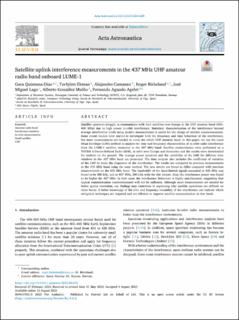| dc.contributor.author | Quintana Diaz, Gara | |
| dc.contributor.author | Ekman, Torbjörn | |
| dc.contributor.author | Camanzo, Alejandro | |
| dc.contributor.author | Birkeland, Roger | |
| dc.contributor.author | Lago, José Miguel | |
| dc.contributor.author | Muíño, Alberto González | |
| dc.contributor.author | Aguado, Fernando | |
| dc.date.accessioned | 2023-12-06T07:29:08Z | |
| dc.date.available | 2023-12-06T07:29:08Z | |
| dc.date.created | 2023-11-14T11:17:05Z | |
| dc.date.issued | 2023 | |
| dc.identifier.citation | Acta Astronautica. 2023, 212 624-629. | en_US |
| dc.identifier.issn | 0094-5765 | |
| dc.identifier.uri | https://hdl.handle.net/11250/3106130 | |
| dc.description.abstract | Satellite operators struggle to communicate with their satellites over Europe in the UHF amateur band (430–440 MHz) due to high power in-orbit interference. Statistical characterisation of the interference beyond average interference levels using in-orbit measurements is useful for the design of suitable countermeasures. Some recent studies have started to investigate both the frequency and time behaviour of the interference, but more measurements are needed to cover the whole UHF amateur band. In this paper, we use the Local Mean Envelope (LME) method to analyse the time and frequency characteristics of in-orbit radio interference from the LUME-1 satellite, measured in the 437 MHz band. Satellite measurements were performed on a TOTEM Software-Defined Radio (SDR), in orbit over Europe and Antarctica and the results were downloaded for analysis on the ground. The average power spectrum and the variability of the LME for different time windows in the 437 MHz band are presented. The data analysis also includes the coefficient of variation of the LME to study the dispersion of the interference. The results are compared to previous measurements in the 435 MHz band using the same method. The new results are found to differ compared with previous measurements on the 435 MHz band. The bandwidth of the band-limited signals measured at 435 MHz was found to be 300 kHz, and at 437 MHz, 200 kHz wide for this dataset. Also, the interference power was found to be higher for 437 MHz. In both cases the interference behaviour is highly non-Gaussian, suggesting that typical communication countermeasures will not be sufficient. Although more measurements are needed for better spatial resolution, our findings may contribute to explaining why satellite operations are difficult on these bands. A better knowledge of the time and frequency variability of the interference can indicate which mitigation techniques are required and are efficient to improve satellite communication in that band. | en_US |
| dc.description.abstract | Satellite uplink interference measurements in the 437 MHz UHF amateur radio band onboard LUME-1 | en_US |
| dc.language.iso | eng | en_US |
| dc.publisher | Elsevier B. V. | en_US |
| dc.relation.uri | https://www.sciencedirect.com/science/article/pii/S0094576523004095 | |
| dc.rights | Navngivelse 4.0 Internasjonal | * |
| dc.rights.uri | http://creativecommons.org/licenses/by/4.0/deed.no | * |
| dc.title | Satellite uplink interference measurements in the 437 MHz UHF amateur radio band onboard LUME-1 | en_US |
| dc.title.alternative | Satellite uplink interference measurements in the 437 MHz UHF amateur radio band onboard LUME-1 | en_US |
| dc.type | Peer reviewed | en_US |
| dc.type | Journal article | en_US |
| dc.description.version | publishedVersion | en_US |
| dc.source.pagenumber | 624-629 | en_US |
| dc.source.volume | 212 | en_US |
| dc.source.journal | Acta Astronautica | en_US |
| dc.identifier.doi | 10.1016/j.actaastro.2023.08.010 | |
| dc.identifier.cristin | 2196350 | |
| dc.relation.project | Ministerio de Ciencia e Innovación (MICINN): ESP2016-79184-R | en_US |
| dc.relation.project | Norges forskningsråd: 270959 | en_US |
| dc.relation.project | Norsk romsenter: TIN21024 | en_US |
| cristin.ispublished | true | |
| cristin.fulltext | original | |
| cristin.qualitycode | 1 | |

